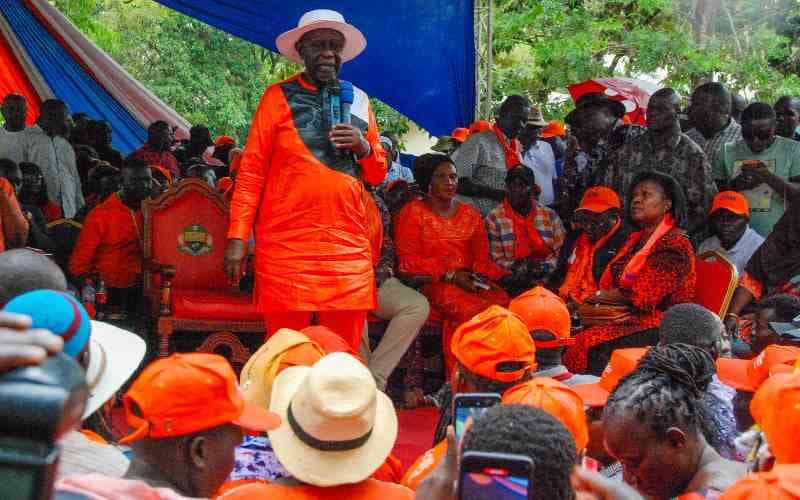We're loading the full news article for you. This includes the article content, images, author information, and related articles.
Following Raila Odinga's death, Kenya's political landscape is in flux as the Orange Democratic Movement faces a succession crisis while President William Ruto strategically plans a government reshuffle to consolidate power ahead of 2027.

NAIROBI, KENYA - The death of veteran opposition leader Raila Odinga on October 15, 2025, has triggered a seismic shift in Kenyan politics, leaving his Orange Democratic Movement (ODM) party grappling with a profound leadership vacuum and threatening to unravel the country's delicate political balance. As ODM navigates its uncertain future, President William Ruto is reportedly preparing a significant cabinet reshuffle, a move widely seen as a strategic effort to capitalize on the opposition's disarray and fortify his administration for the 2027 general election.
In the immediate aftermath of Odinga's passing, ODM's National Executive Council appointed his elder brother, Siaya Senator Dr. Oburu Oginga, 82, as the interim party leader. The appointment, confirmed by the party's Central Management Committee on Monday, October 27, is viewed as an attempt to provide stability during a turbulent transition. However, the party is contending with deep internal divisions that have existed for months but were largely contained by Odinga's unifying authority.
Two main factions have emerged, creating an ideological rift over the party's direction. One group, described as conservatives, advocates for continuing the 'broad-based government' cooperation agreement forged between Odinga and President Ruto. This faction, which includes figures like Homa Bay Governor Gladys Wanga and Treasury Cabinet Secretary John Mbadi, argues that remaining in government honors Odinga's final wishes for national unity and stability. On Monday, the party officially reiterated its commitment to this arrangement until 2027.
Conversely, a group of 'radicals', led by the outspoken Secretary-General Edwin Sifuna, is pushing for ODM to exit the pact and reclaim its traditional role as the lead opposition party. This faction believes ODM must field its own presidential candidate in 2027 to protect Kenya's multi-party democracy. Political analysts like Herman Manyora have suggested that Sifuna represents a necessary generational shift for the party's survival beyond the Odinga era.
President Ruto, while publicly mourning Odinga as a statesman, is moving swiftly to reshape the political terrain to his advantage. Speculation is rampant in Nairobi's political corridors about an imminent cabinet reshuffle designed to consolidate power. The changes are expected to accommodate new allies, most notably KANU chairman Gideon Moi, who recently entered into a cooperation agreement with the President. This alliance is seen as a move by Ruto to broaden his political base.
The reshuffle presents a complex challenge for the President, who must balance rewarding new partners with maintaining stability within his ruling coalition. The constitution limits the number of cabinet secretaries, meaning some incumbents may be dropped to create space for new appointees. This has reportedly caused significant anxiety among current ministers. Furthermore, the President must manage competing interests from his own UDA party and allies in the Mount Kenya region, who are wary of losing influence.
The twin developments—ODM's internal power struggle and Ruto's government restructuring—signal a period of profound political realignment in Kenya. The fragmentation of ODM, which holds the second-largest number of seats in parliament, could weaken the opposition's ability to provide checks and balances on the executive. For years, Odinga was the gravitational center of opposition politics, and his absence leaves a void that no single figure currently appears capable of filling. This could lead to a more dominant ruling party and potentially alter the dynamics of the 2027 presidential election.
The stability of Kenya, an economic powerhouse and democratic anchor in East Africa, is crucial for the region. Odinga's death occurred just months after his unsuccessful bid for the African Union Commission Chairmanship in February 2025, a campaign that had been backed by the Kenyan state and leaders across East Africa. The current political uncertainty could impact Kenya's diplomatic engagements and its leadership role on regional issues. As the nation adjusts to a political landscape without one of its most iconic figures, the actions of both ODM's new leadership and President Ruto in the coming weeks will be critical in shaping Kenya's democratic future and its standing in the region.
Keep the conversation in one place—threads here stay linked to the story and in the forums.
Other hot threads
E-sports and Gaming Community in Kenya
Active 6 months ago
Popular Recreational Activities Across Counties
Active 6 months ago
The Role of Technology in Modern Agriculture (AgriTech)
Active 6 months ago
Investing in Youth Sports Development Programs
Active 6 months ago